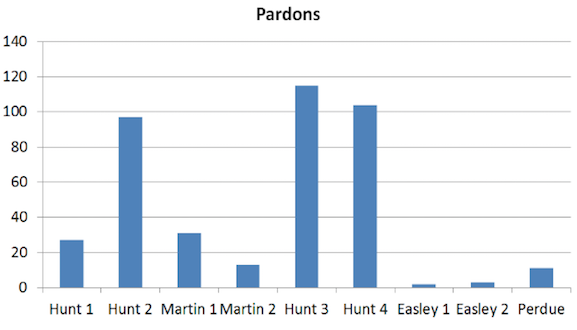Rascals case in brief
In the beginning, in 1989, more than 90 children at the Little Rascals Day Care Center in Edenton, North Carolina, accused a total of 20 adults with 429 instances of sexual abuse over a three-year period. It may have all begun with one parent’s complaint about punishment given her child.
Among the alleged perpetrators: the sheriff and mayor. But prosecutors would charge only Robin Byrum, Darlene Harris, Elizabeth “Betsy” Kelly, Robert “Bob” Kelly, Willard Scott Privott, Shelley Stone and Dawn Wilson – the Edenton 7.
Along with sodomy and beatings, allegations included a baby killed with a handgun, a child being hung upside down from a tree and being set on fire and countless other fantastic incidents involving spaceships, hot air balloons, pirate ships and trained sharks.
By the time prosecutors dropped the last charges in 1997, Little Rascals had become North Carolina’s longest and most costly criminal trial. Prosecutors kept defendants jailed in hopes at least one would turn against their supposed co-conspirators. Remarkably, none did. Another shameful record: Five defendants had to wait longer to face their accusers in court than anyone else in North Carolina history.
Between 1991 and 1997, Ofra Bikel produced three extraordinary episodes on the Little Rascals case for the PBS series “Frontline.” Although “Innocence Lost” did not deter prosecutors, it exposed their tactics and fostered nationwide skepticism and dismay.
With each passing year, the absurdity of the Little Rascals charges has become more obvious. But no admission of error has ever come from prosecutors, police, interviewers or parents. This site is devoted to the issues raised by this case.
On Facebook
Click for earlier Facebook posts archived on this site
Click to go to
Today’s random selection from the Little Rascals Day Care archives….
Click for earlier Facebook posts archived on this site
Click to go to
Today’s random selection from the Little Rascals Day Care archives….
Is clinging to error really ‘how science progresses’?
 Nov. 30, 2012
Nov. 30, 2012
In 1993 (January-February issue), the journal Child Abuse & Neglect published “Sexual Abuse of Children in Day Care Centers” by Susan J. Kelley, Renee Brant and Jill Waterman. This is from the article’s abstract:
“Sexual abuse of children in day care center settings has received considerable attention in the past decade. The nature and extent of allegations of sexual abuse in day care poses unique challenges to clinicians. Cases of sexual abuse in day care typically involve multiple victims and multiple perpetrators, and use of extreme threats to prevent disclosure….”
The article’s misinformation has spread far beyond its original readership. Google Scholar shows “Sexual Abuse of Children in Day Care Centers” to have been cited in other publications no fewer than 36 times, as recently as this year.
I asked Child Abuse & Neglect to publish a retraction.
I received this response from editor-in-chief David A. Wolfe, professor of psychology and psychiatry at the University of Toronto:
“The journal only retracts papers if there are significant errors or other problems, such as plagiarism, health risks etc. Otherwise, it is up to the scientific community to decide when new knowledge or findings would usurp those previously published. This is the case in many areas of research, whereby older (sometimes well-accepted) findings are no longer given credence due to newer findings. It is not feasible or appropriate to remove the previous findings, as that is how science progresses.
“Unless you are aware of specific errors in the 1993 data, rather than drawing different conclusions, the journal would not take any further action.
“I trust this resolves your concerns.”
Well, no, actually it doesn’t. This is what I wrote back to Dr. Wolfe:
“The problem with ‘Sexual Abuse of Children in Day Care Centers’ is not a matter of ‘different conclusions’ being drawn from the data. The entire concept of the article is false: There was never any ‘multiple victim, multiple offender’ sexual abuse in day cares, any more than there was witchcraft in Salem. As has been thoroughly documented by social scientists such as Stephen J. Ceci and Maggie Bruck, and eventually validated in the legal system, all these ritual-abuse cases resulted from a moral panic.
“This passage is from the Retraction Guidelines of the Committee on Publication Ethics: ‘Retraction is a mechanism for correcting the literature and alerting readers to publications that contain such seriously flawed or erroneous data that their findings and conclusions cannot be relied upon. Unreliable data may result from honest error or from research misconduct.’
“And this is from Tom Reller (vice president of global public relations at publisher Elsevier): ‘Our journals, and academia overall, do better when shining a light on bad actors and bad science.’ ”….
“This is my concern, not yours, but ‘bad science’ fostered numerous convictions in Little Rascals, McMartin and other day care prosecutions of the 1980s and early 1990s. A retraction in a journal such as yours would be a significant step toward obtaining true exoneration for these defendants.”
No response from Dr. Wolfe. Maybe he’s reconsidering?
Parents saw nothing amiss until rumors took hold
 April 18, 2012
April 18, 2012
“One of the more surprising aspects of this (Little Rascals) case…. was that none of the parents… had observed anything that caused them to suspect their children were being abused or tortured during the period of the alleged abuses; there were no reports of unusual incidents from their children.
“Nor did the parents detect anything unusual when, without notice, they dropped in early to pick up their children from the day care (e.g., to take them to a doctor’s appointment).
“It was only after allegations began to grow that parents also began to remember events or behaviors consistent with their child being abused.”
– From “Jeopardy in the Courtroom: A Scientific Analysis of Children’s
Testimony” by Stephen J. Ceci and Maggie Bruck (1995)
Prosecutor Nancy Lamb gave the Charlotte Observer her response to “Jeopardy in the Courtroom”: “It’s unfortunate that these two people who have a good reputation – or at least Ceci did – have written this. It’s garbage.”
How Edenton resembled Guantanamo Bay

Google Earth
Guantanamo Bay, Cuba, left; Edenton, N.C.
Jan. 2, 2016
“The CIA’s use of its enhanced interrogation techniques was not an effective means of acquiring intelligence… and on several occasions produced inaccurate information….
“Despite declaring the program a ‘success,’ there was no evidence of any independent evaluation concluding that it was effective, only internal assessments by CIA officials and contractors with a financial interest in the program.
“The CIA rarely reprimanded or held personnel accountable for serious and significant violations, inappropriate activities, and systemic and individual management failures….”
– From “20 Key Findings from CIA Torture Report” in Congressional Quarterly News (Dec. 9, 2014)
Sound familiar? Too little prudence, too much hubris?
Yes, the Pentagon’s recent recognition of the American Psychological Association’s disavowal of practices at Guantanamo brings to mind a different kind of “enhanced interrogation” – no waterboarding, but just as corrupt.
The Little Rascals prosecution’s well-paid and single-minded therapists seem to have recognized no ethical barriers in extracting phony claims from the children they interrogated so relentlessly. And neither prosecutors nor therapists were ever held accountable.
![]()
Clemency now rare; is it fear of blowback?
 Dec. 8, 2013
Dec. 8, 2013
“Obviously, there’s a modern trend towards more limited use of executive clemency that extends beyond the current president. I speculate that the increased media scrutiny given to pardons and commutations has made presidents reluctant to exercise clemency…..
“The same trend… may be present in North Carolina as well…. Most of Governor Easley’s pardons were in cases in which DNA evidence exonerated the defendant, while almost all of Governor Perdue’s pardons concerned the racially tainted Wilmington 10 cases…. It is too early to tell how much, or how little, Governor McCrory will exercise executive clemency.”
– From “Do Only Turkeys Get Pardons?” by Jeff Welty at the North Carolina Criminal Law blog (Dec. 5)
The chart above, compiled by Welty, a faculty member at the University of North Carolina School of Government, depicts poignantly the odds faced by Junior Chandler and others pursuing clemency from recent North Carolina governors.
Since Jim Hunt left office in 2001, pardons have become historically scarce, paralleling the drop-off at the presidential level. But that smattering of clemency, as Welty points out, is most like to occur in December, under cover of the Christmas spirit.











0 CommentsComment on Facebook